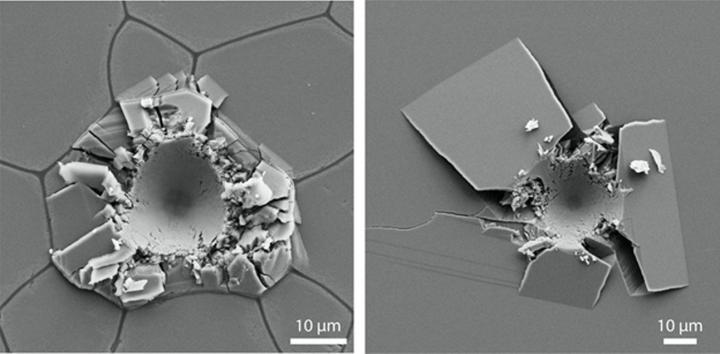
Credit: Virginia Tech
Ling Li, an assistant professor in mechanical engineering at Virginia Tech, has found insights into building stronger and tougher ceramics by studying the shells of bivalve mollusks.
This perspective is formed by looking at the capacity of the basic mineral building blocks in the shell to anticipate fractures, instead of focusing only on the shape and chemistry of the structure. The results of his group’s findings were published in the Nov. 10, 2020, issue of Nature Communications.
Li’s team conducted an in-depth analysis of the microscopic structures of the shells of pen shell mollusks, bivalves native to the Caribbean. The shells of these animals consist of two layers, an inner nacre layer and a brown-colored outer layer. The inner nacre layer, also known as mother-of-pearl, is often iridescent due to its regular nanoscopic layering structure, similar to the coloration mechanism for many bottlefly wings.
Li’s team focused their attention to the outer layer, which is composed of prism-shaped calcite crystals arranged in a mosaic pattern. Between adjacent mineral crystals, very thin (approximately 0.5 micrometers, less than one-hundredth the size of a human hair) organic interfaces are present that glue the crystals together. The calcite crystals measure approximately half a millimeter in length and 50 micrometers in diameter, resembling elongated prisms.
Unlike many geological or synthetic crystals, where the atoms within their crystalline grains are perfectly arranged in a periodic fashion, the calcite crystals in the pen shells contain many nanoscopic defects, primarily composed of organic substances.
“You can consider the biological ceramic, in this case the pen shells’ calcite crystals, as a composite structure, where many nanosized inclusions are distributed within its crystalline structure,” said Li. “This is especially remarkable as the calcite crystal itself is still a single crystal.”
Normally, the presence of structural defects means a site of potential failure. This is why the normal approach is to minimize the structural discontinuities or stress concentrations in engineering structures. However, Li’s team shows that the size, spacing, geometry, orientation, and distribution of these nanoscale defects within the biomineral is highly controlled, improving not only the structural strength but also the damage tolerance through controlled cracking and fracture.
When these shells are subjected to an outside force, the crystal minimizes plastic yielding by impeding the dislocation motion, a common mode for plastic deformation in pure calcite, aided by those internal nanoscopic defects. This strengthening mechanism has been applied in many structural metal alloys, such as aluminum alloy.
In addition to adding strength, this design allows the structure to use its crack patterns to minimize damage into the inner shell. The mosaic-like interlocking pattern of the calcite crystals in the prism layer further contains large-scale damage when the external force is spread across the individual crystals. The structure is able to crack to dissipate the external loading energy without failing.
“Clearly these nanoscopic defects are not a random structure, but instead, play a significant role in controlling the mechanical properties of this natural ceramic”, said Li. “Through the mechanisms discovered in this study, the organism really turns the originally weak and brittle calcite to a strong and durable biological armor. We are now experimenting possible fabrication processing, such as 3D printing, to implement these strategies to develop ceramic composites with enhanced mechanical properties for structural applications.”
###
This work is partially supported by the Institute for Critical Technology and Applied Science at Virginia Tech and the Air Force Office of Scientific Research.
Media Contact
Suzanne Irby
[email protected]
Original Source
https:/




